![]()
Meteor-wrongs
Another photo gallery of the usual suspects.
Over the past decade, various people have contacted me asking for help in getting their "meteorite" identified. In recent years, what with meteorites being mentioned more in the media, there isn't a week that goes by that I don't get asked, "How much is my rock worth?". But not one of those rocks was ever a meteorite; it was always a "meteor-wrong".
I'm not complaining, because a lot of my colleagues get contacted with similar questions, but many more times than me. In particular, are those webmasters with highly-ranked websites, as well as, those members of academia that have a "web presence", and in doing so, have made themselves more approachable by the general public. How they ever get any work or research done, I'll never understand. But recently, I experienced what that must be like.
One day, I was contacted by an associate producer for the Pawn Stars program on the History Channel. They wanted me to appraise some meteorites that viewers were trying to bring onto the show to "pawn". The producer never admitted it, but I'm sure I wasn't the first "expert" that they contacted. Nevertheless, they had a lot of specimens that "finders" were wanting to drag into the pawn shop.
Well, guess what? None of them were meteorites. Every one of them was a meteor-wrong. Now, the meteor-wrong plague was a problem that had extended to the entertainment industry.
But the associate had already sold the Executive Producer and Director on filming a "meteorite episode" and now they were desperate. They asked me what I thought about an episode involving a meteor-wrong, but I talked them out of that idea. Then they told me that they found someone who had found a large iron meteorite near Barstow in the California Mojave Desert, but later when they told the finder I was going to conduct an examination and appraisal, the finder immediately changed his story and confessed that he bought it in a garage sale. It was then that I learned I was to be part of the episode and that my meteorite ID and appraisal was to be part of the filming. They finally found a real meteorite for me to appraise in the planned episode. But that's another story.
What I'm trying to say in this story is that I'm not proud of my appearance on Pawn Stars, but I am proud that I had the opportunity to keep a batch of meteor-wrongs and transported meteorites off of TV, off of the market, and out of collections.
After that Pawn Stars episode aired where I made my initial appearance as the "meteorite expert", a lot more people started to contact me with their "meteorites". And the deluge of emails and phone calls is still increasing. Just trying to be polite and replying to every one of them is becoming too time-consuming. So, I've decided to do something. I've postponed my planned article and have decided that this month's article would, instead, address the "meteor-wrong problem". In addition, I wanted to make a compilation of meteor-wrong images that I could refer to the people that were contacting me. I could then point to this gallery and say to those people, "See, you're not alone. Your specimen is very similar to all of these other rocks that are NOT meteorites."
[Yes, I know this has already been done (and I might add, in very excellent fashion) by Randy Korotev and Ken Newton, but I wanted to make a webpage that was more personal.]
This latest influx of meteor-wrong images made it even more apparent to me that there were many similarities among them. I noticed that most meteor-wrongs can fit into 3 broad categories:
Artifact iron - - (I've broadened this term to include any malleable iron or alloy that isn't an iron meteorite.)
Iron oxide - - (This is a broad grouping that includes hematite and magnetite, as well as any basalt or jasper that attracts a magnet. Personally, I prefer to exclude any "iron shale" that can be proven that it originated from an iron meteorite.)
Slag - - (I've broadened this term to include any material that is man-made, or the residue from a manufacturing process, such as any ore that only partially melted.)
Since two out of the three above categories are outside the domain of geological sciences, I now refer people to metallurgists. I'm serious. Since the vast majority of meteor-wrongs sent to me are either slag or metal, why would I send someone to a Junior College Geoscience instructor for an ID?
Here is an example of what I mean:
Even if you are lucky enough to find someone that you can pay and get a detailed quantitative analysis, you rarely get a detailed explanation of what the results mean. Below, the suspect "meteorite" contains no malleable iron or natural silicates, yet it is primarily composed of silicon and iron. The proper analysis of the test results should conclude "silicide of iron", but that would require the expertise of a metallurgist. This is not an analysis that you should expect a community college geoscience instructor to make. Usually, no analysis is made, and the client is left to decipher the oracle on their own.
![]()
And here is an image of the specimen that was tested:
![]()
Meteor-wrong - - probably Ferrosilicon alloy, or iron disilicide - - (man-made)
In this instance the finder had already spent a good deal of time and money getting his rock examined by a variety of experts (he used the term "geologists" but I couldn't confirm that, let alone get the actual name of these experts). The rock was even analyzed (he had a print-out of test results). I wasn't sure why he contacted me, but he finally got around to asking me if I would broker his find? I told him that I did know buyers, but that I would have to see his specimen first. That same day he drove 100 miles to meet me. We met for lunch, but "the drinks were on me" (which is a euphemism, meaning that I had to inform him that his rock was a meteor-wrong).
And here is an image of the (large) specimen that was tested:
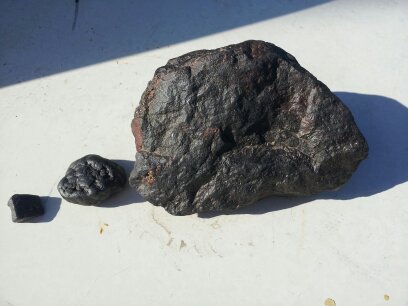
Meteor-wrong - - a mixture of hematite/magnetite - - (iron oxide)
My take on all of this is that the "meteor-wrong probem" is multi-faceted. Yes, there are too many of them, and yes, there are more and more of them "coming out of the woodwork" (for a variety of reasons). But with respect to the people with MWs contacting me, their common complaint is that they don't know where to go, or who to ask. Hard to believe in this modern age of Google, but apparently the Internet is failing these people.
Aside from the problem of researchers wasting their time with meteor-wrongs, my concern is for those people who have succeeded in navigating the web and have found "experts" and "geologists", yet are still unable to get a proper ID for their rock. The process has failed those people. And it compounds the "meteor-wrong problem". It's as if no one wants to ID a rock, let alone tell a person that their find is a meteor-wrong. We could use more help from those in the geoscience field in this regard. Here's a suggestion. All requests for a rock/meteorite ID should go through a Geology Department before being handed over to a researcher. In fact, many meteoriticists are already turning away packages and are no longer accepting these requests.
But as long as people think that, what they have found is "for sure" a meteorite, they will continue to pursue contacting a meteorite-expert in order to confirm their hopes. Hopefully, this gallery of meteor-wrongs will give those hopeful people reason to pause, and to consider that their rock might be terrestrial. Now their task is to find an expert in terrestrial rocks.
Gallery of Meteor-wrongs:
the following images were taken by people who were trying to get their specimens identified.
They are all meteor-wrongs.
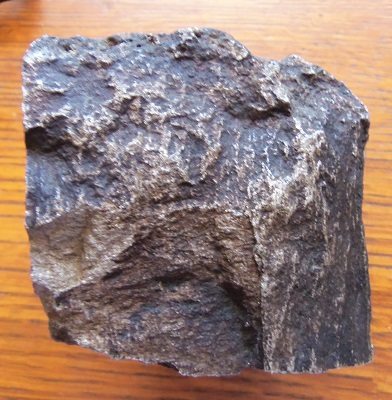
Meteor-wrong - - probably a ferro-manganese alloy - - (man-made)
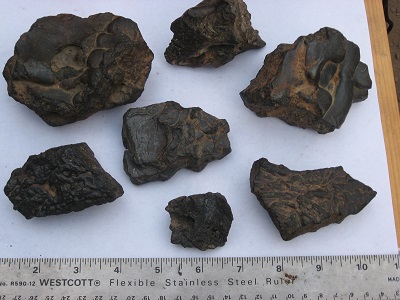
Meteor-wrong - - various forms of "slag" - - (man-made)
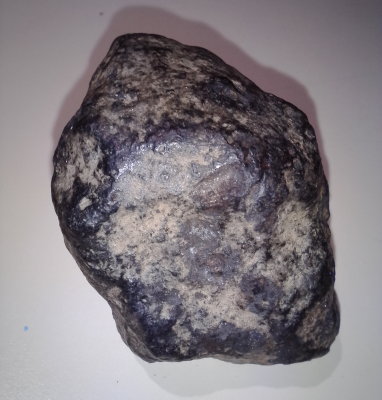
Meteor-wrong - - probably a variety of "slag" - - (man-made)
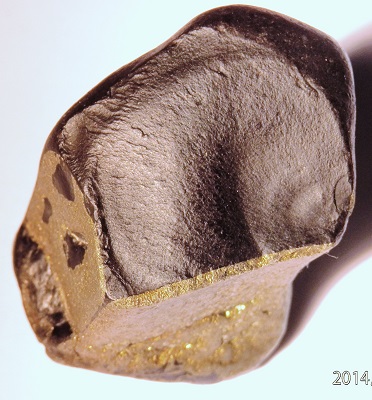
Meteor-wrong - - probably a ferro-manganese alloy - - (man-made)
Sometimes the meteor-wrongs can be colorful.
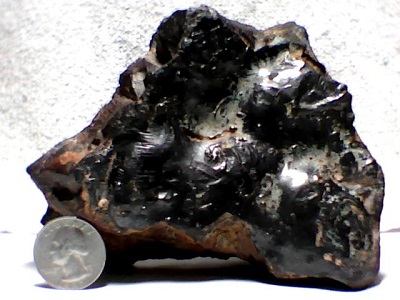
Meteor-wrong - - probably another variety of "slag" - - (man-made)
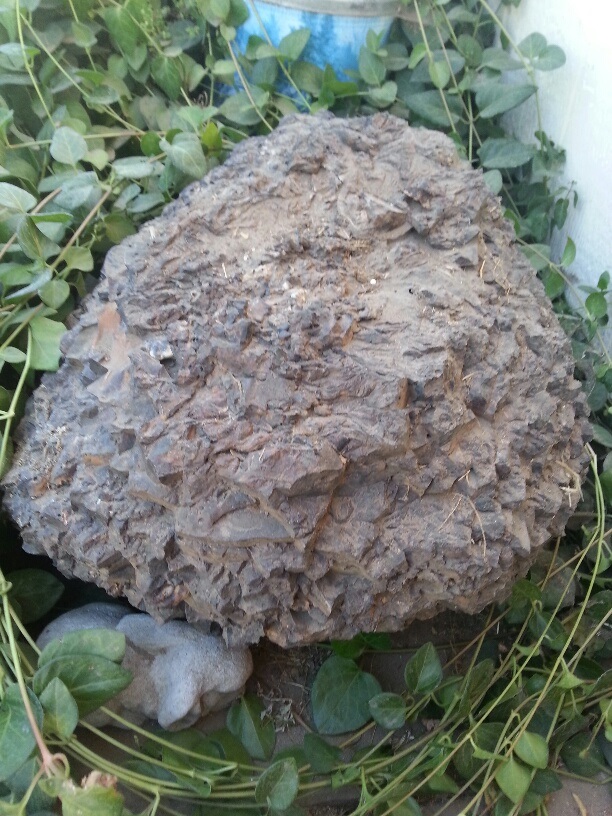
Meteor-wrong - - probably another variety of "slag" - - (man-made)
Sample that was sent to me was relatively copper-rich, but
it was still a man-made material, another type of slag.
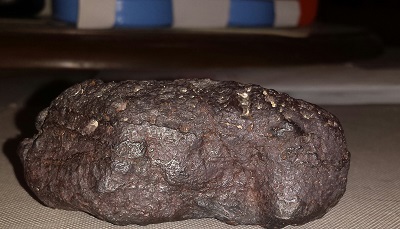
Can't confirm the ID of this rock just by this image.
I would have to see this specimen first-hand, at least,
before ruling-out that it is not a meteorite. Doesn't look man-made.
Looks like it belongs to my Group#2 (iron oxide).

Now, this specimen I did see first-hand.
And it was such a disappointment that it was
"terrestrial" (a mix of various iron oxides) that
the finder just handed it to me and said, "Just take it away."
I did, and my wife still has it in her rock-garden.
Post Script:
In the future, additional meteor-wrong images will appear HERE.
Ferromanganese - one of Ken Newton's "meteorite-identification.com" very informative webpages.
MeteorWrongs - an extensive "photo gallery" of rocks that people thought were meteorites, part of Randy Korotev's very instructional website.
Ferrochromemanganese - this Cascadia Meteorite Laboratory webpage is on the Portland State University website.
